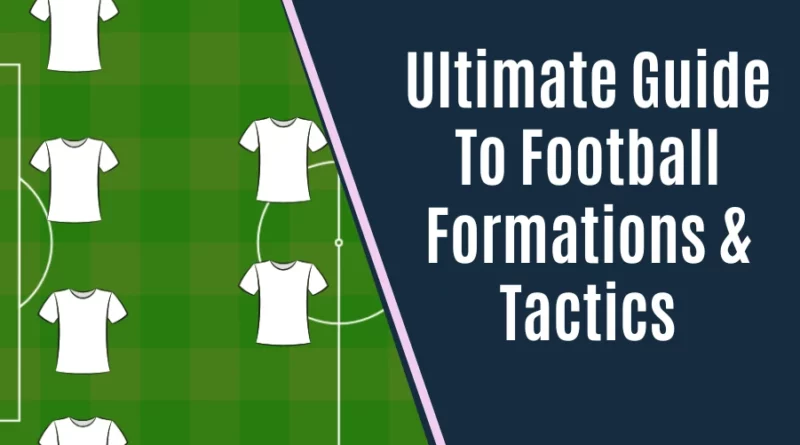An Ultimate Guide to Football Formations and Tactics (4-4-2, 4-3-3 and more)
Formation in football is an essential part of every game. Every manager has a different take on the formations based on their ideology, tactics, players available at their disposal, etc. Football formations have evolved a lot in the last 100 years. Today, let us take a deep dive into the world of football formations, how to interpret them, their evolution and the current iterations of formations. Formation in football refers to the positions in which players of a team line up on the pitch. Since football is a fluid sport, a player named in one position can move into another position based on the game state, unlike other sports like American Football and Rugby.
Football formations are usually designated for outfielders only. A goalkeeper’s position is fixed, and it is never mentioned in any formation. Formations are denoted by numbers separated by hyphens. They are to be read from left to right. The leftmost number usually denotes the defence and the number of players playing in defence. The next number to its right usually recognises the number of players in midfield, and the number on the right refers to the number of attackers. The sum of all numbers in any formation will always be 10 since the goalkeeper isn’t included. This numerical system of reading formations was developed in the 1950s.
A standard example of this notation is 4-4-2, which indicates 4 defenders, 4 midfielders and 2 forwards.
However, this might not always be the case, as sometimes the players might not line up in a single line in either midfield or attack. In these cases, the formation is broken down into multiple numbers. The numbers are split into two separate bands, or even three, according to the positions the players take on the pitch. The positions in midfield and up front (forwards) have to be carefully evaluated.
An example of this is 4-2-3-1, where the midfield is split into two defensive midfielders and three offensive midfielders. The leftmost notation of the 4 defenders and the rightmost notation of the attacker remain the same.
Evolution of Football Formations
Football was played like a mob sport till the early 1850s. The game took a massive step forward when it turned pro from amateur. Plenty of rules were introduced that standardised the number of players, pitch sizes and the game conditions. However, not much emphasis was put on the positions of players. Football formations were very nomadic back then. There was no such thing called defending as players often dribbled the ball without passing. It eliminated the need for a specialist defender, and all the players used to attack in unison.
The first well-noted formation that was widely used in England and beyond was the 2-3-5. Originally known as the “Pyramid”. In the guidebook by Caxton published in 1960, he recognised that the formation had been in use since 1877. The formation struck a balance between attack and defence at a time when playing in defence was stigmatised. Five attackers were used in the final third, and three players were deployed near the halfway line, known as “Halfbacks”. They acted as the first line of defence and had the responsibility of winning the ball back and recycling it into attack.
If the trio of halfbacks were beaten, the attackers would run into the two Fullbacks who acted as the last line of defence. This formation gave rise to the convention of shirt numbers increasing from back to front. This Pyramid formation was interpreted differently across Europe, and new systems came out as its derivatives. The Danubian school of football was developed in the Balkans and saw tweaks made in the forward line.
Italy’s Vitorio Pozzo derived the WW formation known as Metodo from the Danubian school. The shape on the paper resembled two Ws drawn between the players on the pitch. It was a radical change from the 2-3-5 as he pulled two forwards into midfield and named them inside forwards. This gave the team a defensive superiority over their opponents. It resembled a 2-3-2-3 and helped win back-to-back World Cups in 1934 and 1938. Pep Guardiola famously used Pozzo’s systems during his time at Barcelona and Bayern Munich, after nearly 70 years, to steamroll opponents.
Herbert Chapman of Arsenal then revolutionised the game in England in the early 1930s as he reacted to a change in the offside laws. He dropped a halfback from the 2-3-5 system into the fullback role and created a centre-half role. This went on to become the modern “centre-back” position. The formation now resembled the WM shape on the paper. His Arsenal side played with a 3-2-2-3 on paper, as they stopped attacks better and were fluent on the break. They conquered England and provided the rest with a template, as most English clubs lined up in a 3-2-5 or a 3-4-3 resembling Chapman’s WM shape. Champman’s system was developed by Italian coach Nereo Rocco and Argentine Helenio Herrera into Catenaccio in Italy. They developed an ultra-defensive approach by locking up attacks with three centre-backs and strong playmakers counter-attacking.
The next step in the evolution of football formations was the deployment of a four-player defence. Though the changes were made in Hungary through Marton Bukovi, the Brazilian national coach, Flavio Costa, is hailed as the creator of it. Another Hungarian, Bela Guttman, also deserves credit for it. They dropped another halfback into defence and created a back four. It had two centre-backs in the middle of the pitch and two full-backs holding the width. Two halfbacks protected the defence, and the attack had four forwards spread across the width of the pitch. The system was a further development of the WW system, adding more attacking threats.
Brazil’s success at the World Cups with this formation prompted many clubs across Europe to use this formation. Most notably, Jock Stein’s Celtic won the European Cup in 1967 and finished as runners-up in 1970 with 4-2-4. Hence, the football formations that started with 2 at the back eventually developed into 3 and 4 at the back, solidifying defence. This struck a fine balance between attack and defence and led to a more balanced sport.
These standardised formations were given their own spin by legendary tacticians from Germany and the Netherlands. Johan Cruyff, the Dutch legend, developed “Total Football”. It emphasised fluid movement, player interchangeability and a high-possession style of play. It is important to note that these formations come into the limelight and fade out of relevancy during certain periods. The football formations invented in the 1930s were relevant to that period and were slowly phased out as tactics and players developed.
The three-at-the-back Christmas tree formation that faded out in the 1970s was revived by Pep Guardiola in 2023, leading to widespread acceptance again in the 2020s. This tells us that formations keep evolving regularly and also find a great callback value to outthink the opposition.
Also Read: Top Most Popular and Widely Used Soccer Formations
List of the Best Formations in Football History
Now, as we have seen formations rise to glory and fade out regularly, let us go through some of the best formations in world football history. These formations are being used regularly in 2025 as well. For convenience, let us break down these formations into three categories. The three, four and five at the back families.
Three At the Back Families
3-4-3
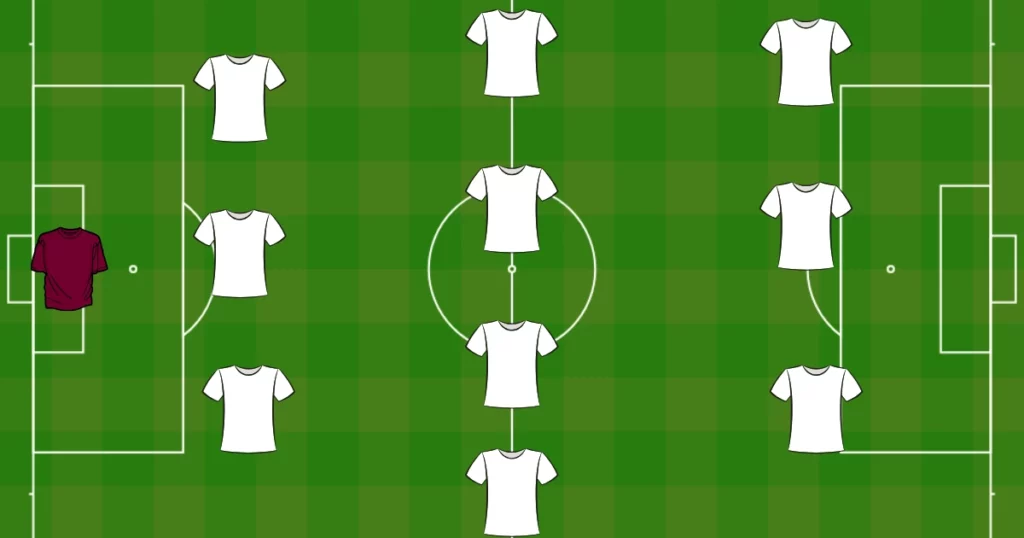
In this formation, a bank of three defenders acts as the last line of defence. They are protected by two central midfielders who must be proficient with screening the ball as well as progressing it. The width is supplied by two wing-backs who must be well-rounded to lend a hand in both attack and defence. The forward line has a trident where the striker is flanked by pacy wingers. The three at the back families are mostly used by Italian coaches as a part of their catenaccio philosophy. However, it was also used by many coaches who believed in a defence-first principle.
Strengths: The front three can pin down the back four of an opposition by playing narrowly. This gives the wingbacks a great chance to run riot out wide. Also, the wingbacks can make a back five when under pressure, making it difficult for the opposition to break them down.
Weakness: Wingbacks can either make or break the system, as their versatility and ability to shift on both ends can decide games. The midfield is also overwhelmed as the pivot can be occupied by the opposition’s midfield.
Examples: Antonio Conte won the Premier League with Chelsea in 2017, and Thomas Tuchel used it to lift the Champions League in 2020 with Chelsea.
3-4-2-1
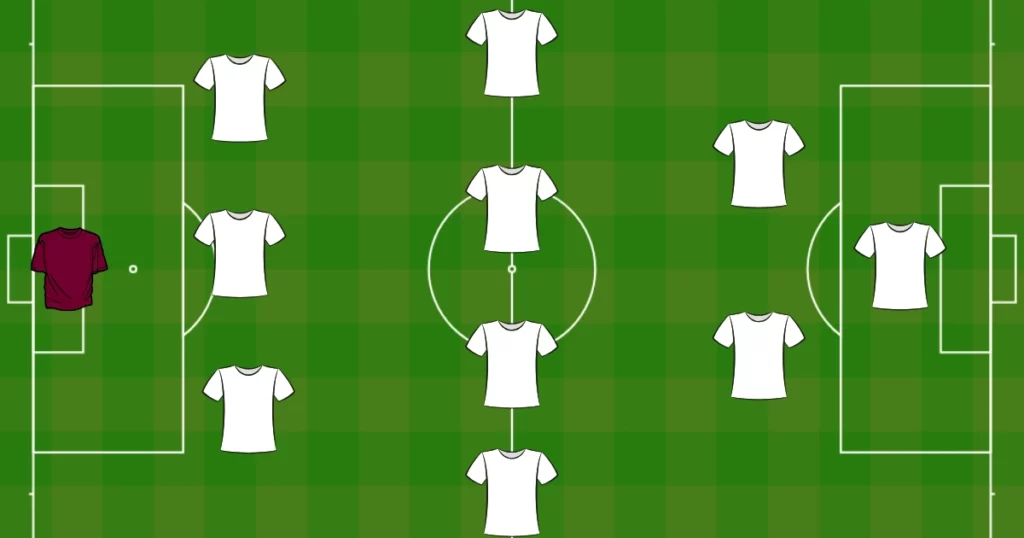
In this iteration, the forwards in a 3-4-3 play are slightly withdrawn in the forward line. They play similarly to the number 10 role, but on either side of the striker instead of alongside them. This formation adds some steel in the middle of the pitch, but the flanks can be overloaded if the opposition wingers and full-backs try to stretch the pitch.
Strengths: The number 10s can drop into the midfield and create a box midfield. It offers great numerical superiority and can be used to counterattack quickly.
Weakness: The width is non-existent in this formation as the striker is isolated with no support alongside him.
Examples: Xabi Alonso’s Bayer Leverkusen won the Bundesliga in 2024 using this swashbuckling formation. Ruben Amorim found immense success at Sporting with this as well.
3-2-4-1
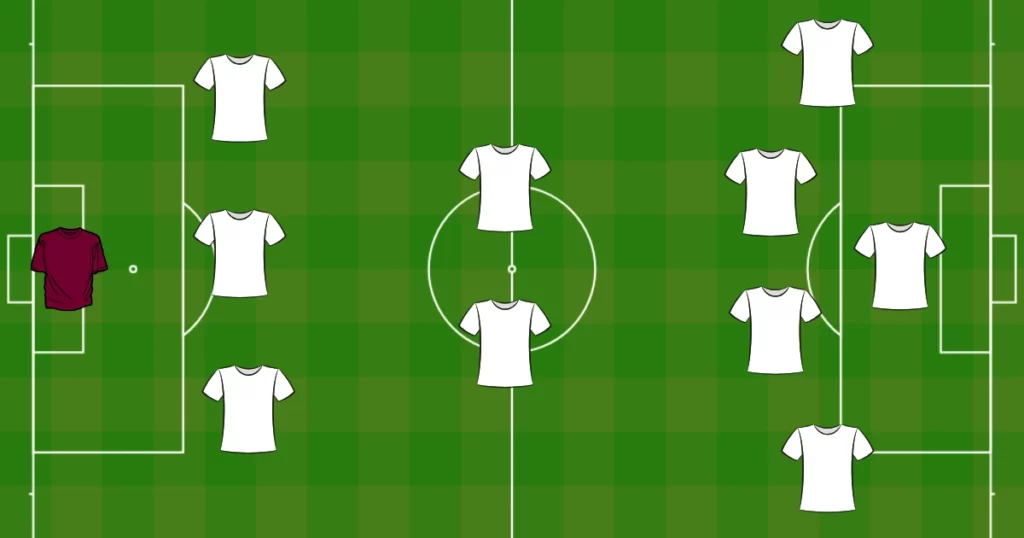
This is an extremely attacking formation as it offers numerous advantages in the buildup. The back three is protected by a box midfield. The defensive pivot screens the back line, and there are two eights in front of them. The eights often function as inside 10s as they push high into the attack. Two wide players supply the width and join the striker if needed. This formation was developed by Pep Guardiola recently when he read about it in a football textbook. He inverted a defender into the midfield to create better build-up plays and dismantle the opposition.
Strengths: Passing options are available from all angles to the players. The box provides greater security in the middle of the pitch.
Weakness: The width on the pitch has to be provided by the midfielders without any backup. It needs players of extremely high technical and fitness levels to pull it off.
Examples: Pep Guardiola ran through Europe with this midseason invention to run away with the treble in 2023.
3-5-2
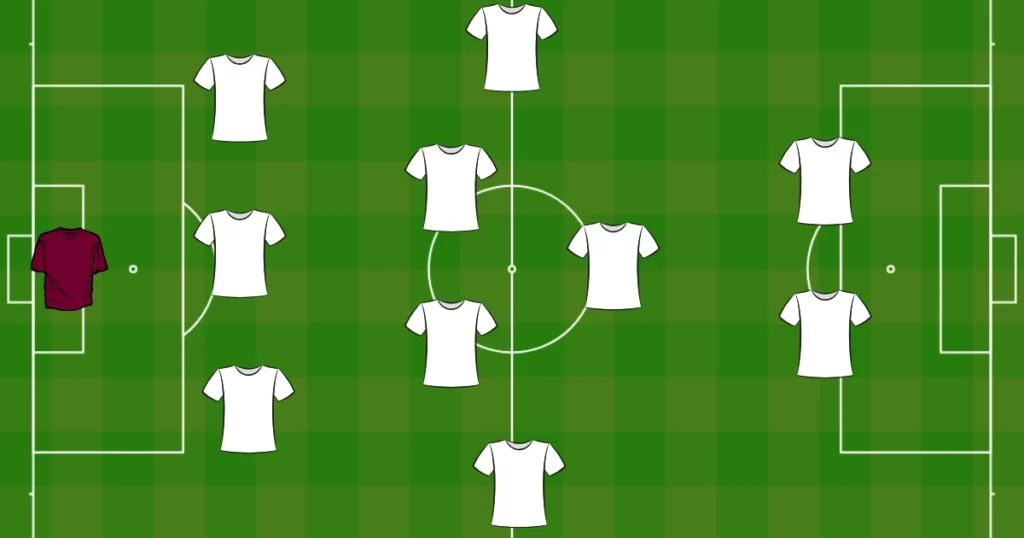
The midfield unit has three players in the centre and two players out wide. The three-player advantage in the centre of the pitch is crucial for teams to win the battle. The two strikers occupy the centre-backs and bring the others into play. This option adds a lot of steel to the defence and midfield. However, the strikers have to be powerful enough to pin down the opposition, and the wing-backs should be able to run all day.
Strengths: A strong forward line with a runner from midfield can take the game away in minutes. The defence can play out from the back easily, with three options in the middle available to them.
Weakness: Just like the other 3 at the back systems, this system also demands high levels of skill to execute it perfectly.
Examples: Simone Inzaghi’s Inter Milan won the Serie A in 2024 with this strong approach.
Also Read: Understanding Soccer Positions: A Full Breakdown and Explanation
Four At the Back Families
4-4-2
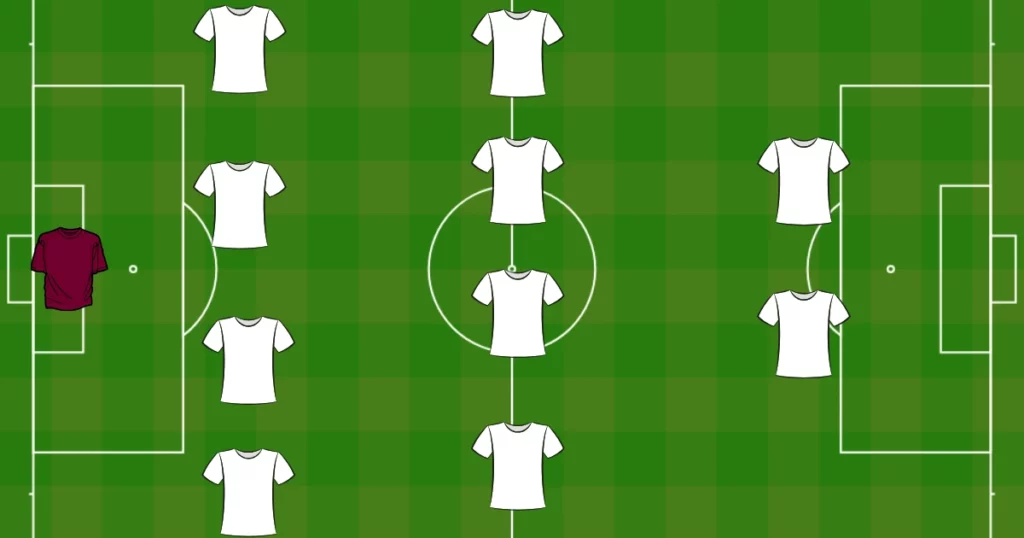
They say all good things come in pairs, and such is the case with 4-4-2. It has a pair of centre-backs, a pair of fullbacks, a pair of midfielders, a pair of wingers and, of course, a pair of strikers. This simple yet effective formation was every manager’s meat and drink back in the early 2000s. It was simple for everyone to execute, but only those with world-class personnel went all the way to win titles.
Strengths: Offers excellent defensive solidarity as two banks of four can be impregnable at times. Great chances to play on the breakthrough four forwards.
Weakness: The players are all in the same vertical line, as one pass through the lines can carve the defence wide open. This formation requires quite a lot of understanding between the players.
Examples: Sir Alex Ferguson’s Manchester United ruled England through this. Arigo Sacchi’s Milan showed the world how to do it as well.
4-4-1-1
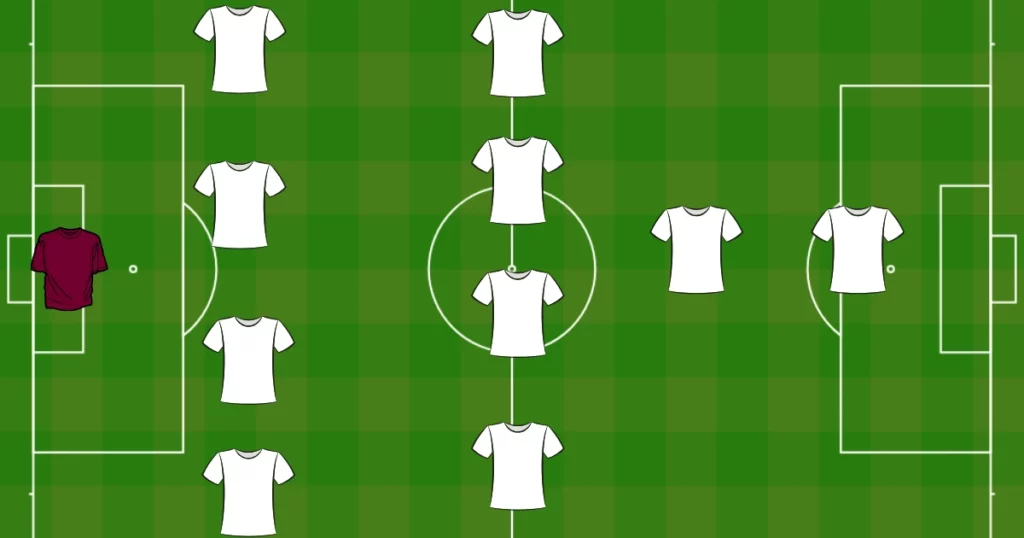
A slight tweak on the usual 4-4-2, as there is only a single striker instead of two target men. The other forward plays slightly behind the striker, almost as an attacking midfielder. The midfield and defence still stay the same, but the striker can get isolated if the supply line is cut off. The second forward holds the aces in unlocking the defences.
Strengths: The presence of a playmaker allows a better chance of creation.
Weakness: This formation is perfect for the underdog, as teams with better resources stray away from this.
Examples: Claudio Ranieri’s Leicester City completed their fairytale Premier League title win in 2016 using this.
4-2-2-2
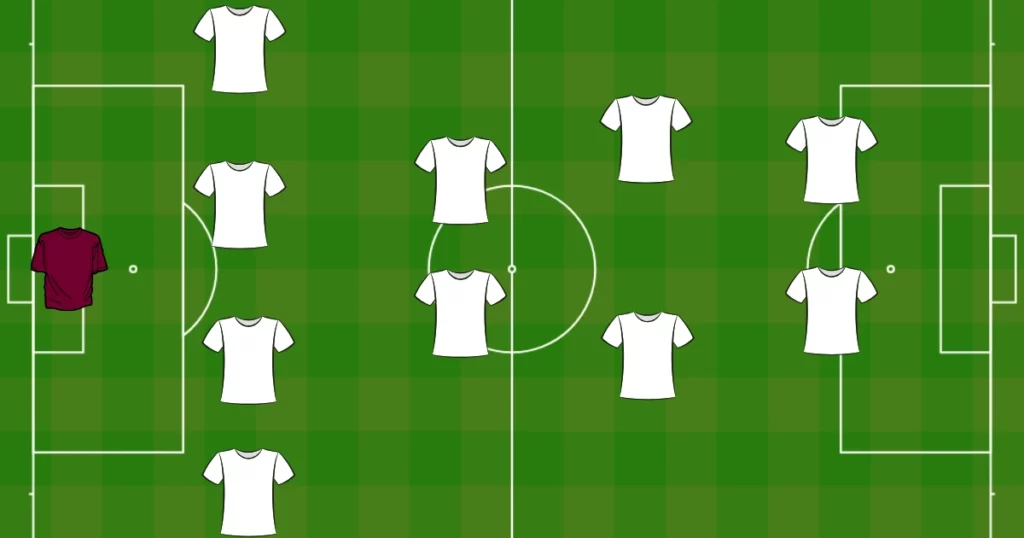
This is a standard 4-4-2 formation with a slightly different midfield build. Instead of a flat midfield four, there are two defensive midfielders and two slightly wider attacking midfielders instead of the usual wingers to attack the half spaces. This is also known as the magic rectangle formation, as the four players in midfield positions like the vertices of a rectangle, but in a staggered way.
Strengths: Uses the midfield rotation to maximum effect to exploit the half-spaces through attacking midfielders.
Weakness: The defence is left a bit short as the attacking midfielders aren’t famously known for their work ethic.
Examples: Manuel Pellegrini’s Manchester City won the Premier League using this football formation.
4-1-2-1-2
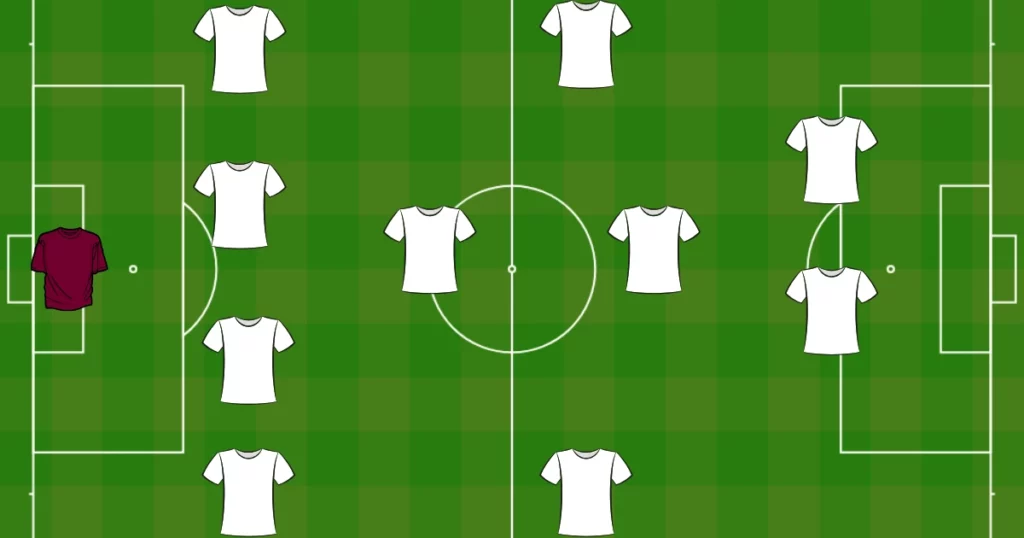
Another version of 4-4-2 that acts as a bridge to the popular 4-3-3. This formation is also called a diamond, as the midfield shape often resembles a diamond. The midfield 4 is split into a defensive midfielder at the base, a couple of eights just in front of them and a number 10 playing at the tip of the diamond. This formation has very little width as the central midfielders often play very close to each other. The onus of attacking falls on the fullbacks.
Strengths: Greater flexibility in attack as a number 10 plays behind the two strikers with a lot of room to run into.
Weakness: Width becomes an issue as the eights have to cover the central areas as well as the wider areas to protect fullbacks.
Examples: Real Madrid won the Champions League with extreme quality in their ranks.
4-3-3
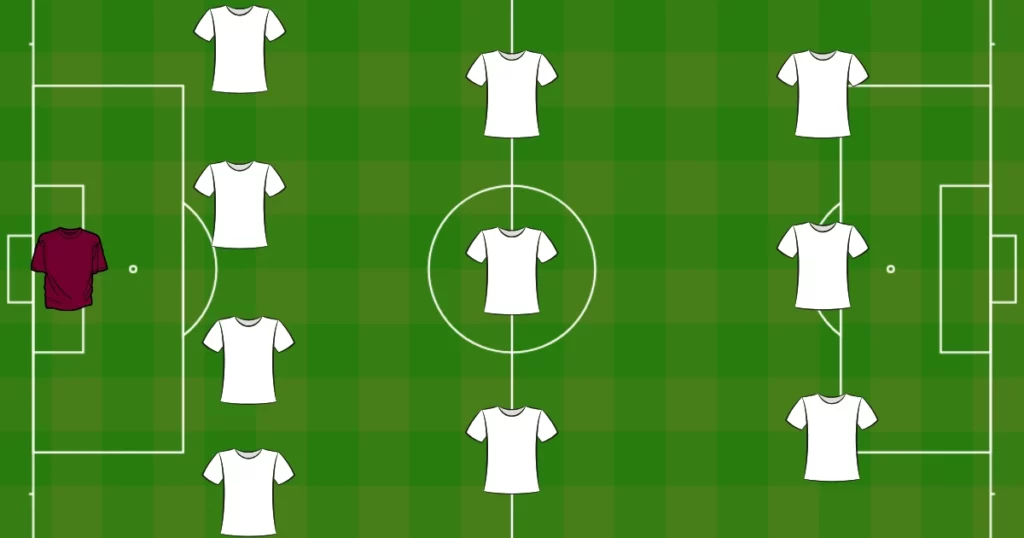
A simple formation on paper, but something that revolutionised world football. This football formation has three midfielders on the pitch and an attacking trident on top. The midfielder’s roles vary widely from manager to manager. They can be simply used as actors in the midfield like everyone else. They can be used as workhorses like how Jurgen Klopp used them, or like a deep-lying playmaker, an attacking midfielder and a tempo controller like Pep Guardiola’s legendary sides. The forward line is pretty functional, too, as there is a lot of width provided by the wingers who stretch the pitch. Some of the most attacking formations in football used this to create dangerous front threes like MSN (Messi, Suarez, Neymar) and BBC (Bale, Benzema, Cristiano).
Strengths: This formation allows the creation of passing triangles all over the pitch. As three men protect the defence, it grants fullbacks the chance to overlap and contribute to the attack.
Weakness: Since the wingers stretch the pitch, there is a chance that the forward might get isolated if not backed well by the midfield. Also, the midfield three can be overwhelmed by runners in the midfield.
Examples: Pep Guardiola’s Barcelona defined an era with fluid 4-3-3 and tiki-taka football. Jurgen Klopp’s Gegenpressing 4-3-3 at Liverpool saw them return to the glory years.
4-2-3-1
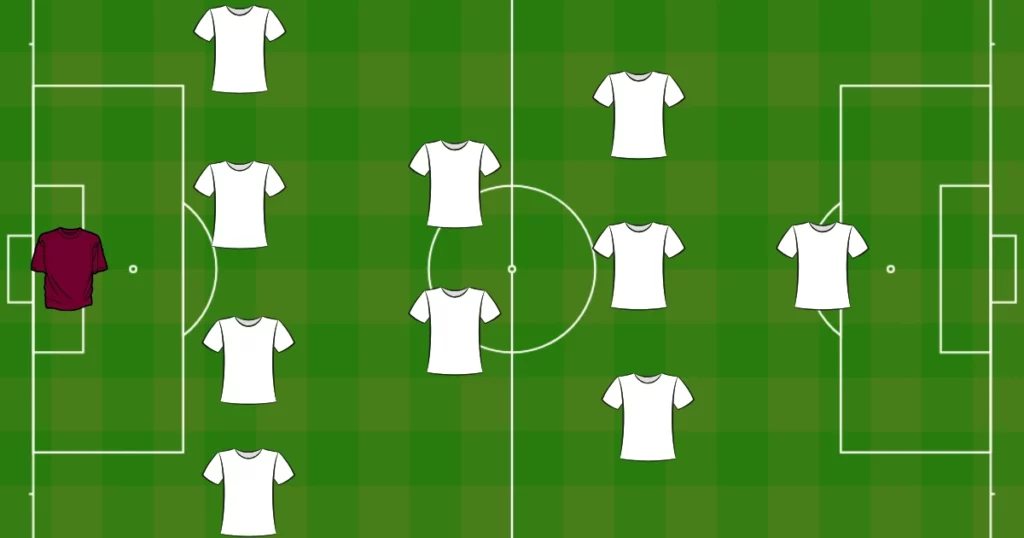
A tweaked version of 4-3-3 for more stability defensively. The midfield three is split into two defenders and an attacking midfielder. A couple of wingers from the forward line play slightly withdrawn and flank the number 10 instead of the striker. This is considered one of the best attacking formations in football as it provides scope for four forwards and two wingbacks to join the attack if the midfield pivot and centre-backs can deal with fast breaks.
Strengths: The presence of a double pivot in the middle of the park offers a lot of steel to the midfield. The number 10 can link up with the wingers and the striker to take up decent goal-scoring opportunities.
Weakness: If the fullbacks choose to attack, the midfield will have to cover twice as much ground to get back defensively. If the number 10 does not drop back, the midfield can quite easily get overwhelmed.
Examples: Almost all the World Cup winning squads in the 2010s used this formation as Spain, Germany and France made merry.
4-3-2-1
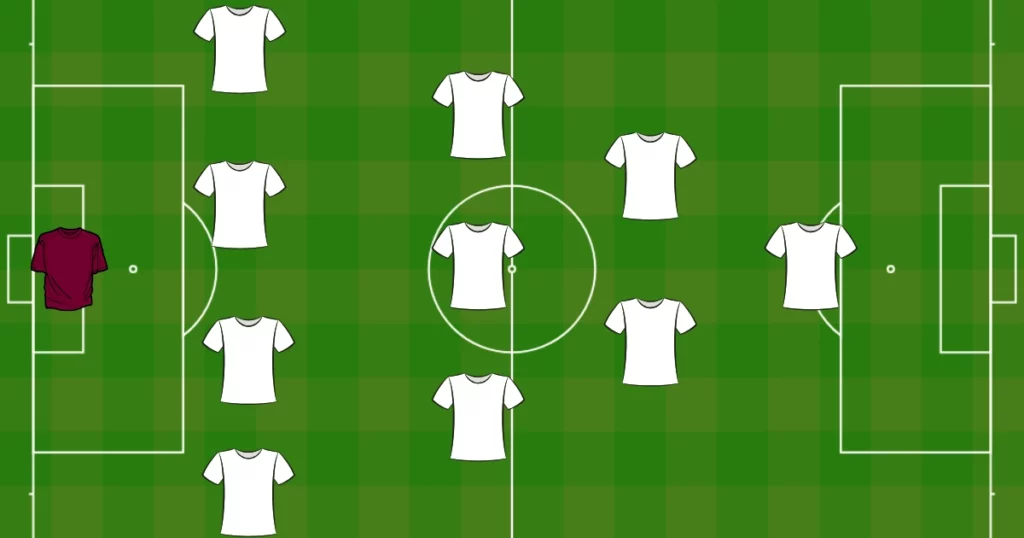
Lovingly known as the Christmas Tree formation due to the decreasing numbers in line from back to the front, this is also a different version of 4-3-3. The wingers play narrowly and behind the striker on either side of them. The three central midfielders provide a lot of passing angles in the buildup, and the defence is well protected. But the attack can struggle as the width aspect of it is compromised.
Strengths: It offers a lot of numerical superiority in the middle of the park. It can help the attacks flow through the centre of the pitch through wingers and attacking midfielders.
Weakness: The width entirely depends on the engine of the full-back pairing, who plays a key role in the success of this.
Examples: Carlo Ancelotti found immense joy with this at Milan and Real Madrid.
Also Read: Top 5 managers with comfortable formations and tactics in the world of football
Five At the Back Families
5-3-2
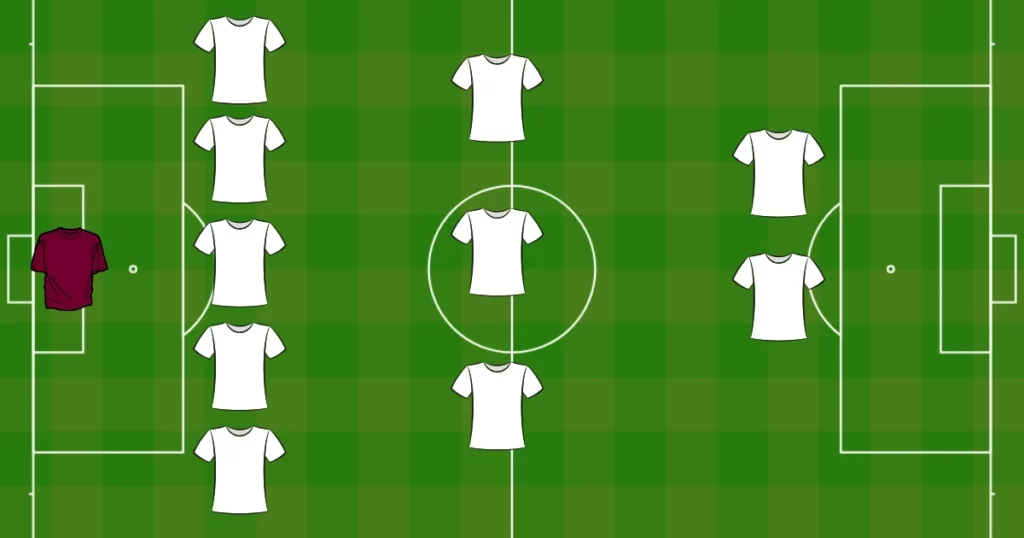
This formation is the pinnacle of a deep-block formation as it favours deep defending. The three centre-backs are flanked by two wing-backs who almost entirely stay back in defence. The midfield has a ball winner and a couple of eights who prioritise mainly on ball winning. The forwards upfront act as target men and pin down the opposition defenders. Not many teams start the game with this formation, but they do end up using it if they want to close out the games. Sometimes, we might see this formation right from the start in David vs Goliath matchups to shore up defence.
Strengths: The defensive line can lock down any attack by packing their own box with numbers.
Weakness: The attack entirely depends on the strikers having a good game, as the lineup is set out to defend.
Examples: Ruben Amorim and Mikel Arteta can switch to this formation to see out games or against high-profile opposition.
5-4-1

This formation has a certain bite to it as there are wingers at the expense of a striker. This gives the chance for the defence to soak up even more pressure and release it quickly down the wings. The defence is rock solid in this formation, but the wide midfielders have to play a key role as they have to efficiently attack and defend. The lone striker might be isolated, but they need to stay in the game to take any chance that comes their way.
Strengths: Up to nine defensive bodies can shut the shop if you are looking to close out the game. The wingers and fullbacks can double up on the opposition in defence.
Weakness: Strength can so quickly turn into weakness if the defence is found out once. It might be a long wait for the final whistle.
Examples: In theory, this is similar to the WW formation that Italy used to win the World Cups in 1934 and 1938.
Some of the Best Attacking Formations in Football
The best attacking formations in football stem from various families. A simple 3-4-3 can be quite lethal if the fullbacks can match the speed of their wingers. Even 4-4-2 can be clinical if the team can soak pressure before releasing it through their wingers and forwards.
However, the most in-demand football formations right now in the world are 4-3-3 and 4-2-3-1. Johan Cruyff’s total football gave a new meaning to 4-3-3, and Pep Guardiola revolutionised that formation. He put a deep-lying playmaker at number six instead of a ball-winner to keep moving the ball. The other midfielders had the job of simply retaining possession and rotating it with the defence in triangles. Once the window opens up, they play short and incisive passes forward into the attackers, who pose a triple threat up top.
Jürgen Klopp’s heavy-metal football saw the midfield act as centre-backs and full-backs as the wide defenders bombed forward into attack. These two modern-day greats gave the entire footballing world a decent blueprint to use.
Another formation that is quite attacking in nature, despite being defensively sound, is 4-2-3-1. The cousin of 4-3-3 has a midfield pivot to defend transitions better. The presence of an attacking midfielder allows for better central creativity. The striker can often drop in as a false nine, allowing the wingers to make dangerous runs in behind.
These are some of the best-attacking football formations in use recently.
Also Read: Ranking the 10 Best Right Backs in the World: From Achraf Hakimi To Malo Gusto
FAQs
What is the weakness of 4-2-3-1?
An aggressive full-back pairing will leave the defence exposed, as there would only be two banks of two players each protecting the goal.
What is false 9 in soccer?
A false 9 is a striker who doesn’t attack the box but drops deep and plays alongside the attacking midfielder to make the play.
Which teams played the best with 4-3-3?
Pep Guardiola’s Barcelona and Manchester City played the best football with 4-3-3.
Does any team still use 4-4-2?
Atletico Madrid’s Diego Simeone still plays a version of 4-4-2 and 4-4-1-1 regularly.
